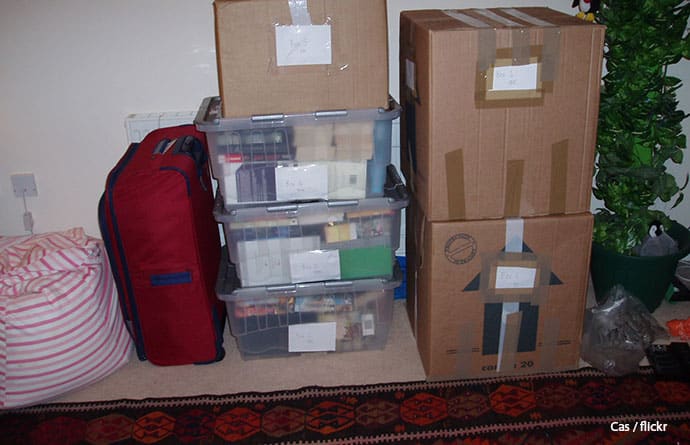
Are the days of the cardboard box for moving home numbered?
The humble cardboard box has always been the default mode of moving your household items from old to new homes.
They are sturdy, durable, and plentiful, but the downside is that they have to be constructed and deconstructed, they require packing tape which adds considerably to your home moving costs, and what do you do with the mound of boxes after moving day?
Yes, you can give them away, recycle or keep them for future use. But just the process of deconstructing and flattening the boxes after moving day is time-consuming and laborious.
So what if there was a modern, equally versatile, and cheap alternative to cardboard boxes for packing your goods when moving home?
You may also like to read: How to Choose the Right Boxes for Moving Home. In this guide, we look at the best sizes, thicknesses, and types of boxes to use when packing for a home move. There is also an interesting section on cardboard box trivia.
Which Boxes are Best for Moving Home? Cardboard Boxes vs Plastic Boxes

Do reusable plastic moving bins herald the end of the cardboard box for home movers?
There are now companies, such as Crate Hire UK, who will hire you, by the week, varying sizes of plastic totes for moving home.
This appears to be a great service and has many benefits over using cardboard boxes for your home move:
The Pros of Using Plastic Crates for Packing
- They will deliver them to you, and then collect them when you have unpacked them.
- Plastic boxes generally work out cheaper than cardboard boxes.
- There is no packing tape to have to buy.
- Packing time will be considerably reduced as you will not need to construct the packing boxes.
- They are friendlier to the environment than cardboard.
- Plastic will not be susceptible to insect damage or infestation.
- No inconvenience of having to dispose of the empty boxes after your home move.
- Tote boxes are stackable so the packing and unpacking process can be more organised.
- Plastic will not get water-damaged as cardboard boxes would.
- Unpacking time will be reduced as there will be no boxes to flatten. Just stack the plastic boxes inside each other ready for collection.
- No more wondering what to do with packing materials after your home move.
- If you decide to buy rather than rent plastic boxes they can be used for indefinite storage as they will not deteriorate over time as cardboard would.
- Hired plastic boxes have a scheduled return date – which is a good motivator to ensure all your unpacking is completed in a timely manner.
However, they are not considered by some in the removal industry as a suitable replacement for cardboard boxes, but is this just a reluctance to accept change?
What is better, plastic or cardboard boxes for moving home, is a topic of hot debate in the industry right now.
The Cons of Using Plastic Crates for Moving Home
The perceived downside of plastic tote boxes is:
- They are not as space-efficient as cardboard boxes due to their tapered shape.
- Tote boxes can slide about in the removal van if not secured properly.
- Some plastic boxes are not as sturdy as cardboard boxes so do not stack as well.
- You have a set date to return the plastic boxes so are on a schedule to unpack them.
If you are using cardboard boxes, one of the key packing materials is the tape that you will use to seal the boxes.
This is really not something that you should try to save money on.
There is little point in having sturdy boxes and then sealing them with inferior-quality tape, the chances are that the moment you try to lift the box the bottom will open, spilling all its contents.
Of course, if you intend to use plastic tote boxes to move home this consideration is mute.
If you want to know how to securely close plastic tubs when moving home, just use zip ties, quick and easy.
The decision to use cardboard boxes or plastic totes to move home will probably be influenced by how you intend to move home.
If doing a self-move or self-packing, you will have the freedom to choose.
If the removal company is packing your home then they will probably supply the packing materials anyway.
But if you have a choice, plastic tote boxes would seem to offer you many advantages over the traditional cardboard box.
You may also like to know: How Many Boxes Do I Need to Move Home? In this guide, we suggest how many boxes, either plastic or cardboard, it takes to pack the average home as well as the average amount of packing materials you will need.





Share your thoughts by leaving a comment